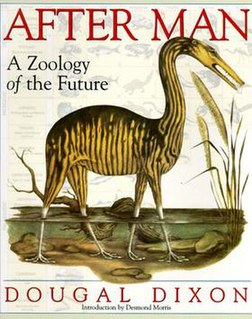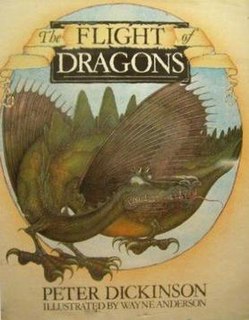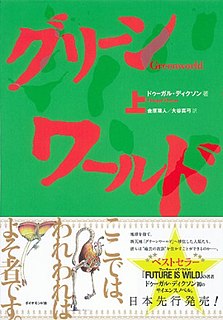 W
WSpeculative evolution is a genre of speculative fiction and an artistic movement focused on hypothetical scenarios in the evolution of life, and a significant form of fictional biology. It is also known as speculative biology and it is referred to as speculative zoology in regards to hypothetical animals. Works incorporating speculative evolution may have entirely conceptual species that evolve on a planet other than Earth, or they may be an alternate history focused on an alternate evolution of terrestrial life. Speculative evolution is often considered hard science fiction because of its strong connection to and basis in science, particularly biology.
 W
WAfter Man: A Zoology of the Future is a 1981 speculative evolution book written by Scottish geologist Dougal Dixon and illustrated by several illustrators including Diz Wallis, John Butler, Brian McIntyre, Philip Hood, Roy Woodard and Gary Marsh. The book also features a foreword by Desmond Morris. After Man explores a hypothetical future set 50 million years from now, a time period Dixon dubs the "Posthomic", which is inhabited by animals that have evolved from survivors of a mass extinction succeeding our own time.
 W
WAlien Planet is a 2005 docufiction TV special created for the Discovery Channel. Based on the 1990 book Expedition by the artist and writer Wayne Barlowe, Alien Planet explores the imagined extraterrestrial life of the fictional planet Darwin IV in the style of a nature documentary. Although closely following Barlowe's depiction of Darwin IV, Alien Planet features a team of scientists and science fiction figures discussing Darwin IV as if it had actually been discovered. Among the people featured are Michio Kaku, Stephen Hawking, Jack Horner, James B. Garvin and George Lucas.
 W
WAlien Worlds is a British sci-fi nature docufiction narrated by Sophie Okonedo. The 4-part miniseries, depicted by using CGI techniques, blends fact with science fiction and conceptualizes what alien life might be like by applying the laws of life on Earth to imagined exoplanets. The series was released on Netflix on 2 December 2020.
 W
WAll Tomorrows: A Billion Year Chronicle of the Myriad Species and Mixed Fortunes of Man is a 2006 work of speculative evolution in science fiction format written and illustrated by the Turkish artist C. M. Kosemen under the pen name Nemo Ramjet. It explores a hypothetical future path of human evolution set from the near future to a billion years from the present. Several future human species evolve through natural means and through genetic engineering, conducted by both humans themselves and by a mysterious and superior alien species called the Qu.
 W
WAll Yesterdays: Unique and Speculative Views of Dinosaurs and Other Prehistoric Animals is a 2012 art book on the palaeoartistic reconstruction of dinosaurs and other extinct animals by John Conway, C. M. Kosemen and Darren Naish. A central tenet of the book concerns the fact that many dinosaur reconstructions are outdated, overly conservative, and inconsistent with the variation observed in modern animals. This focus is communicated through an exploration of views of dinosaurs and related animals that are unusual and sometimes even confusing to viewers, but which are well within the bounds of behaviour, anatomy and soft tissue that we see in living animals.
 W
WAstrobiology, formerly known as exobiology, is an interdisciplinary scientific field that studies the origins, early evolution, distribution, and future of life in the universe. Astrobiology considers the question of whether extraterrestrial life exists, and if it does, how humans can detect it.
 W
WDragon's Egg is a 1980 hard science fiction novel by Robert L. Forward. In the story, Dragon's Egg is a neutron star with a surface gravity 67 billion times that of Earth, and inhabited by cheela, intelligent creatures the size of a sesame seed who live, think and develop a million times faster than humans. Most of the novel, from May to June 2050, chronicles the cheela civilization beginning with its discovery of agriculture to advanced technology and its first face-to-face contact with humans, who are observing the hyper-rapid evolution of the cheela civilization from orbit around Dragon's Egg.
 W
WEvolution is a collection of short stories that work together to form an episodic science fiction novel by author Stephen Baxter. It follows 565 million years of human evolution, from shrewlike mammals 65 million years in the past to the ultimate fate of humanity 500 million years in the future.
 W
WExpedition: Being an Account in Words and Artwork of the 2358 A.D. Voyage to Darwin IV is a 1990 speculative evolution and science fiction book written and illustrated by the American artist and writer Wayne Barlowe. Written as a first-person account of a 24th-century crewed expedition to the fictional planet of Darwin IV, Expedition describes and discusses an imaginary extraterrestrial ecosystem as if it were real.
 W
WFlanimals is a book and a book series written by comedian Ricky Gervais. The book, illustrated by Rob Steen, depicts a list of seemingly useless or inadequate fictional animals, and their behaviour.
 W
WThe Flight of Dragons is a 1979 speculative evolution book written by Peter Dickinson and illustrated by Wayne Anderson.
 W
WFuture Evolution is a book written by paleontologist Peter Ward and illustrated by Alexis Rockman. He addresses his own opinion of future evolution and compares it with Dougal Dixon's After Man: A Zoology of the Future and H. G. Wells's The Time Machine.
 W
WThe Future is Wild is a 2002 speculative evolution docufiction miniseries and an accompanying multimedia entertainment franchise. The Future is Wild explores the ecosystems and wildlife of three future time periods: 5, 100, and 200 million years in the future, in the format of a nature documentary. Though the settings and animals are fictional, the series has an educational purpose, serving as an informative and entertaining way to explore concepts such as evolution and climate change.
 W
WGalápagos (1985) is the eleventh novel published by American author Kurt Vonnegut. Set in the Galápagos Islands after a global financial disaster, the novel questions the merit of the human brain from an evolutionary perspective. The title is both a reference to the islands on which part of the story plays out, and a tribute to Charles Darwin on whose theory Vonnegut relies to reach his own conclusions. It was published by Delacorte Press.
 W
WGreenworld is a 2010 speculative evolution and science fiction book written by Scottish geologist Dougal Dixon and primarily illustrated by Dixon himself, alongside a few images by other artists. Greenworld has, unlike Dixon's previous works on speculative evolution, only been published in Japan, where it was released in two volumes. The book features a fictional alien planet and a diverse biosphere of alien organisms.
 W
WLast and First Men: A Story of the Near and Far Future is a "future history" science fiction novel written in 1930 by the British author Olaf Stapledon. A work of unprecedented scale in the genre, it describes the history of humanity from the present onwards across two billion years and eighteen distinct human species, of which our own is the first. The book employs a narrative conceit that, under subtle inspiration, the novelist has unknowingly been dictated a channelled text from the last human species.
 W
WThe Last Dragon, known as Dragons: A Fantasy Made Real in the United States, and also known as Dragon's World in other countries, is a 2004 British docufiction made by Darlow Smithson Productions for Channel Four and broadcast on both Channel Four and Animal Planet.
 W
W"Living Fossil" is a science fiction story by American writer L. Sprague de Camp, on the concepts of human extinction and future evolution. It was first published in the magazine Astounding Science-Fiction for February 1939. It first appeared in book form in the anthology A Treasury of Science Fiction ; it later appeared in the anthologies Gates to Tomorrow, and The SFWA Grand Masters, Volume 1. The story has been translated into Danish, Swedish and Italian.
 W
WMan After Man: An Anthropology of the Future is a 1990 speculative evolution and science fiction book written by Scottish geologist Dougal Dixon and illustrated by Philip Hood. The book also features a foreword by Brian Aldiss. Man After Man explores a hypothetical future path of human evolution set from 200 years in the future to 5 million years in the future, with several future human species evolving through genetic engineering and natural means through the course of the book.
 W
WMermaids: The Body Found is a television program styled as a documentary originally aired on American TV channels Animal Planet and Discovery Channel. It tells a story of a scientific team's investigative efforts to uncover the source behind mysterious underwater recordings of an unidentified marine body. The show presents the controversial aquatic ape hypothesis as evidence that mermaids exist, along with a digitally manufactured video. A sequel broadcast called Mermaids: The New Evidence aired May 26, 2013.
 W
WThe New Dinosaurs: An Alternative Evolution is a 1988 speculative evolution book written by Scottish geologist Dougal Dixon and illustrated by several illustrators including Amanda Barlow, Peter Barrett, John Butler, Jeane Colville, Anthony Duke, Andy Farmer, Lee Gibbons, Steve Holden, Philip Hood, Martin Knowelden, Sean Milne, Denys Ovenden and Joyce Tuhill. The book also features a foreword by Desmond Morris. The New Dinosaurs explores a hypothetical alternate Earth, complete with animals and ecosystems, where the Cretaceous-Paleogene extinction event never occurred, leaving non-avian dinosaurs and other Mesozoic animals an additional 65 million years to evolve and adapt over the course of the Cenozoic to the present day.
 W
WRhinogradentia is a fictitious order of shrew like mammal invented by German zoologist Gerolf Steiner. Members of the order, known as rhinogrades or snouters, are characterized by a nose-like feature called a "nasorium", which evolved to fulfill a wide variety of functions in different species. Steiner also created a fictional persona, naturalist Harald Stümpke, who is credited as author of the 1961 book Bau und Leben der Rhinogradentia. According to Steiner, it is the only remaining record of the animals, which were wiped out, along with all the world's Rhinogradentia researchers, when the small Pacific archipelago they inhabited sank into the ocean due to nearby atomic bomb testing.
 W
WSeveral organisms are capable of rolling locomotion. However, true wheels and propellers—despite their utility in human vehicles—do not seem to play a significant role in the movement of living things. Biologists have offered several explanations for the apparent absence of biological wheels, and wheeled creatures have appeared often in speculative fiction.
 W
WSnaiad is a speculative evolution, science fiction and artistic worldbuilding project by Turkish artist C. M. Kosemen, focused on a fictional exoplanet of the same name. Begun in the early 2000s and inspired by earlier works such as Wayne Barlowe's 1990 book Expedition, Kosemen has produced hundreds of paintings and sketches of creatures of Snaiad, with detailed ecological roles and taxonomic relationships to each other. The sheer number of invented creatures and lineages makes Snaiad one of the most biologically diverse fictional worlds.